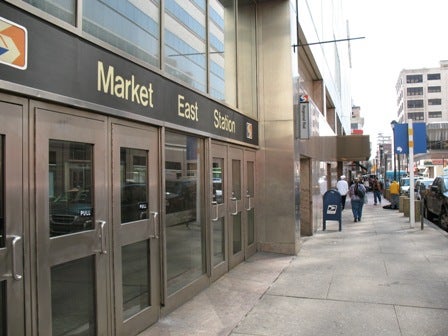Re-urbanization of Market East a winner

Nov. 5
By Kellie Patrick Gates
For PlanPhilly
Instead of a large, nearly monolithic block, Market East could be a series of buildings with lots of residential and retail space, a nightclub, currency exchange and passport office, said five Boston Architectural College students.
That vision won this year’s Bacon Foundation student design competition – an award given at a Monday night gala at the Loew’s Hotel.
“What we are proposing is essentially the re-urbanization of Market East; the completion of a revived Center City that can continue to grow as a high-quality, geographically expansive, livable urban environment that is so rare in the United States,” wrote Nathan Allen, Joe Stromer, David Haugen, Chris Hillebrand and Joel Isaksen in their winning essay. “We would introduce a vital heart to Market East and would let what Bacon would call the organic energy of the city take over.”
The design would turn Market East and the Gallery into an urban hub, anchored by an intercultural center. The center would include a youth hostel, language institute, and cinema. The students also moved the bus depot underground and arranged and designed new buildings that included terracing to add green space above street level.
“As someone whose office used to face the bus terminal, I welcomed the idea of getting rid of it,” joked Paul R. Levy, President and CEO of Center City District in Philadelphia and a contest juror, when he presented the award. But burying the terminal would seriously help connect the Market East area with its surroundings, including Chinatown, he said.
He praised the design for adding more density to the area while keeping a pedestrian-friendly scale at street level.
The competition, in its second year, was designed to “challenge students across North America to focus on urban design problems, while simultaneously raising awareness of the work of Philadelphia’s renowned former Planning Director, Edmund N. Bacon,” according to a competition website.
John Andrew Gallery, a Foundation Board Member who worked as a city planner when Market East was developed, provided a historic overview. When the idea was first conceived in 1963, it was not just to create a transportation hub, but also something to compete with suburban shopping malls, he said.
There were five department stores in Philadelphia at the time, and the idea was that Market East should connect them. The department stores and a bank were really the clients who the planners and designers had to please, Gallery said. And they didn’t like the first few drafts.
But they liked the final vision so much, they decided to move in, he said. And it was this decision to include them that lead to the box-like shape of the building. The decision didn’t go well for the stores, which are now gone. And it hampered the design, he said.
As an aside, Gallery pointed out that it was not a stroke of planning genius that led Market East to stop in its tracks, sparing the Reading Terminal and other historic structures. “It stopped because we didn’t have enough money to tear it down,” he said, clearly relieved, in hindsight, that the money was tight.
Despite the problems with Market East, the basic idea to use it to connect several blocks of the city is good one, Gallery said. “It continues to be a project that has a lot of potential for Philadelphia,” he said, and that’s why this year’s student contest is exciting.
This year’s competitors were asked to devise a way to better connect Market East with the street and the rest of Philadelphia. They were asked to “conceive a new and original concept for improving the site, showing awareness of its historical evolution, the site’s modern users and opportunities, and keeping an eye to the future.”
Read presentations here.
Three honorable mentions were awarded, all to Philadelphia teams:
James S. McKenna III, a third-year student at Temple University’s Tyler School of Art, imagined replacing some Market East sidewalks with an elaborate system of lighted glass panels and photovoltaic film.
Ayako Okutani and Andrew Allwine, fifth-year students at Temple University who also won an honorable mention in last year’s competition, wanted to bring green resting areas and more lunch options to Market East.
Gloria Orfanos, a senior at Drexel University, proposed a series of video and sound receivers that would bring recent city cultural events to passersby. She also proposed a performance space.
Read Q&As with local winners here.
Bacon Foundation President Gregory Heller said the students’ ideas won’t end with the competition.
The winning designs will go on public exhibition for one month in the Cira Centre “bridge” lobby area, which connects the Centre to 30th Street Station.
Beyond that, “These ideas can continue to inform our thoughts and actions” regarding Market East, he said, mentioning that many of the about 150 event attendees are very influential in the world of Philadelphia planning and design.
The Ed Bacon Foundation received 15 entries from individuals and teams, representing the work of 31 students from twelve colleges and universities in seven U.S. states and one Canadian province.
The Connecting Market East winners were selected in mid-October by a professional jury comprised of Elinor Bacon, President of Washington D.C.-based E.R. Bacon Development; John Gallery, Executive Director of the Preservation Alliance for Greater Philadelphia, and a member of the Ed Bacon Foundation’s Board of Directors; and Levy. The first-place team won $2,000. The other winners shared $4,000.
Students were not the only winners. Paul Goldberger, the Pulitzer Prize-winning architecture critic of The New Yorker, received the Foundation’s annual Award for Professional Excellence and also gave the keynote address at Monday’s ceremony.
Goldberger spoke of Bacon’s influence, and of the differences and similarities between Bacon and another urban design expert who has in modern times held even more sway: Jane Jacobs.
Jacobs, who died in 2006, is the author of “The Death and Life of Great American Cities” – a book that criticized 1950s urban renewal.
As strongly as Bacon believed the key to a healthy city was solid, public planning, Jacobs believed that cities should be left alone, to evolve organically, Goldberger said.
Her feelings were informed by what she saw happening around her in New York City in the 1950s, he said. In Greenwich Village, where she lived, public planning was centered around the automobile. A road was planned that would cut the main park there, Washington Square, in half. Likewise, much of industrial SoHo was demolished to make room for a highway. “Their idea of how to make the city better was based on destroying what was there,” Goldberger said.
While that kind of planning was not good for cities, the pendulum should now swing back toward planning – good planning, Goldberger said.
“In some ways, cities have been victims of their own success,” he said. Successful places such as New York and Philadelphia “have become too big and too gentrified” to be left to develop without planners’ guidance.
“Today, the natural order yields something very different from vibrant,” he said. “I don’t think Jane Jacobs could afford to live in her house” in The Village, and neither can writers, actors, planners or teachers – they are priced out, he said.
The natural order yields gigantic, expensive towers in the city, and sprawl outside the city, he said. And it leads to economic segregation.
“We cannot, in the 21st Century, make the argument that we need to leave our cities alone. We cannot leave it all to the private sector,” Goldberg said.
The new generation of urban visionaries are seeing this, he said, but they also were influenced by Jacobs. So they know that planning is vital, but that scrubbing clean an existing block to replace it with something completely different is not the right way.
“Bacon preserved order and figured out how to give new life to the city in the 20th Century,” Goldberger said. “Our job now is the same – to protect the city and renew it for the 21st Century.”
Kellie Patrick Gates is a former Philadelphia Inquirer reporter. Contact her at kelliespatrick@gmail.com
WHYY is your source for fact-based, in-depth journalism and information. As a nonprofit organization, we rely on financial support from readers like you. Please give today.






